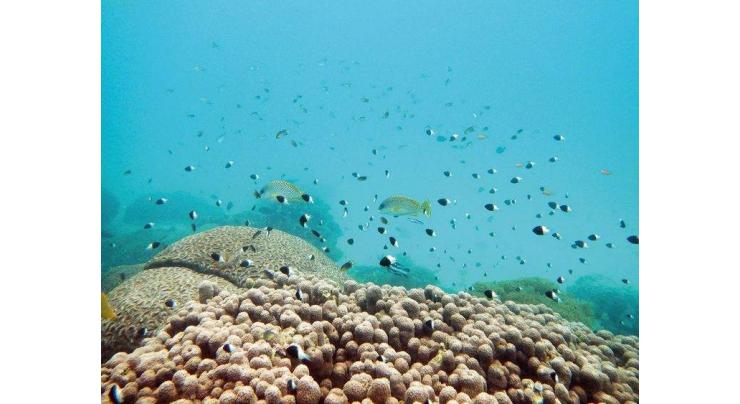
New Treaty Plots Conservation Course For High Seas
Fahad Shabbir (@FahadShabbir) Published March 06, 2023 | 11:27 PM

Protecting life in the vast expanse of ocean beyond national jurisdictions finally has an international roadmap after UN states agreed a landmark high seas treaty at the weekend
Paris, (APP - UrduPoint / Pakistan Point News - 6th Mar, 2023 ) :Protecting life in the vast expanse of ocean beyond national jurisdictions finally has an international roadmap after UN states agreed a landmark high seas treaty at the weekend.
More than a decade in the making, the first international treaty on the high seas aims to promote the conservation and sustainable use of marine biodiversity in international waters -- a vast expanse that covers almost half the planet.
It is seen as essential to conserving 30 percent of the world's land and ocean by 2030, as agreed by world governments in a historic accord signed in Montreal in December.
Ocean ecosystems create half the oxygen humans breathe and limit global warming by absorbing much of the carbon dioxide emitted by human activities.
But only about one percent of the high seas are currently protected.
"What happens on the high seas will no longer be 'out of sight, out of mind'," said Jessica Battle, Senior Global Ocean Governance and Policy Expert, who led WWF's team at the negotiations.
"The High Seas Treaty will allow for the kind of oversight and integration we need if we want the ocean to keep providing the social, economic and environmental benefits humanity currently enjoys." The text, which has now been published, will be formally adopted at a later date once it has been vetted by lawyers and translated into the United Nations' six official languages.
Here are some key points: - Ocean at threat - The treaty begins by recognising "the need to address, in a coherent and cooperative manner, biodiversity loss and degradation of ecosystems of the ocean, due to, in particular, climate change impacts on marine ecosystems".
These impacts include the warming of ocean waters -- the world's seas have absorbed more than 90 percent of the excess heat caused by burning fossil fuels -- along with loss of oxygen, acidification, plastics and other pollutants and overfishing.
The text specifies that it will apply to ocean beyond countries' exclusive economic zones (EEZ), which extend to a maximum of 200 nautical miles (370 km) from the coasts.
It also covers what is known as "the Area", shorthand for seabed and subsoil beyond the limits of national jurisdiction. The Area comprises just over half the planet's seabed.
In principle these measures apply to fishing and mining, although the treaty's decision-making body -- the Conference of the Parties (COP) -- will have to navigate the authority of other regional and global organisations.
Chief among these are regional fisheries bodies and the International Seabed Authority, which currently oversees permits for deep sea mining exploration in some areas and may soon make the controversial move of allowing companies to begin mining.
The treaty will take effect once ratified by 60 countries.
- Marine protections - Currently almost all protected marine areas are within national territorial waters.
The treaty, however, allows for these to be extended to the open ocean to create sanctuaries, particularly in areas that are fragile, unique or crucial for endangered species.
Most decisions would be taken by consensus, but a marine protected area can be voted into existence with a three-quarters majority, avoiding a situation where one country or small group of nations can block a decision.
One crucial shortcoming: the text does not say how these conservation measures will be monitored and enforced over remote swathes of ocean. Some experts say satellites can be used to spot infractions.
Related Topics
Recent Stories

Experts raise concerns over introduction of 10-stick packs

Iranian president arrives in Karachi

Law Minister expresses Govt's resolve to address issue of missing persons

Rizwan’s batting order may be changed: Sources

Nawaz Sharif to visit Guangzhou exhibition in China

FM Dar not traveling to China: Foreign Office

PM takes notice of deliberate delay in tax cases

Iranian President visits Allama Iqbal’s mausoleum

Iranian President arrives in Lahore today

Currency Rate In Pakistan - Dollar, Euro, Pound, Riyal Rates On 23 April 2024

Today Gold Rate in Pakistan 23 April 2024

Islam enlightened world with its teachings about knowledge: Dr Jamileh
More Stories From World
-
Russia rejects US journalist Gershkovich's detention appeal
14 minutes ago -
Prosecutors accuse Trump of 'willful' violations of gag order
53 minutes ago -
French artist JR downsizes at Venice Biennale with Orient Express
2 hours ago -
Umrah & Ziarah Forum 2024: A gateway to enhance pilgrimage services in Holy land
2 hours ago -
16 dead, 28 missing in migrant boat capsize off Djibouti: UN
2 hours ago -
16 dead, 28 missing in migrant boat capsize off Djibouti: UN
3 hours ago
-
How UK's biggest water supplier sank into crisis
3 hours ago -
EU lawmakers greenlight new rules to rein in national spending
3 hours ago -
Hamas to stay in Doha if 'useful' for Gaza war mediation: Qatar
4 hours ago -
London stock market strikes record as sentiment lifts globally
4 hours ago -
In Brazil, hopes to use AI to save wildlife from roadkill fate
5 hours ago -
Taiwan hit by dozens of strong aftershocks from deadly quake
5 hours ago